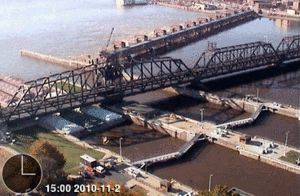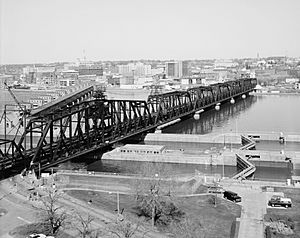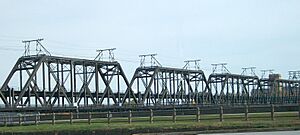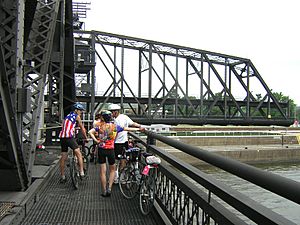Government Bridge facts for kids
Quick facts for kids Government Bridge |
|
|---|---|

The Government Bridge rotating
|
|
| Coordinates | 41°31′09″N 90°34′01″W / 41.51917°N 90.56694°W |
| Carries | 2 lanes of roadway 2 rail lines of Iowa Interstate Railroad |
| Crosses | Mississippi River |
| Locale | Davenport, Iowa and Rock Island, Illinois |
| Maintained by | Federal government of the United States |
| Characteristics | |
| Design | Two riveted Pratt trusses Five riveted Baltimore trusses One pin-connected Baltimore swing truss |
| Material | Steel |
| Total length | 1,608 feet (490 m) |
| Width | 27 feet (8 m) |
| Longest span | 365 feet (111 m) (swing); longest fixed spans 258 feet (79 m) |
| Number of spans | 8 |
| History | |
| Designer | Ralph Modjeski |
| Constructed by | U.S. Army |
| Construction begin | 1895 |
| Opened | 1896 |
| Statistics | |
| Daily traffic | 16,800 |
The Government Bridge (also known as the Arsenal Bridge) crosses the mighty Mississippi River. It connects the cities of Rock Island, Illinois and Davenport, Iowa. This important bridge has two levels. The top level is used by the Iowa Interstate Railroad for trains traveling between Council Bluffs, Iowa and Chicago, Illinois. The bottom level is for cars and trucks, helping people travel easily between the two cities.
The bridge is located near a special spot on the river called Upper Mississippi Mile Marker 483, right next to Lock and Dam No. 15. The bridge you see today was finished in 1896. It's actually the fourth bridge built in this exact spot! All the bridges here have had a special "swing section" that opens up to let big boats and barges pass through on the river.
Contents
History of the Government Bridge
The First Rock Island Bridge: 1856
The very first Rock Island Bridge was built in the 1850s. It was located about 1,500 feet (460 m) upstream (further up the river) from where the current bridge stands. This bridge was super important because it was the first railroad bridge ever built across the huge Mississippi River!
It played a big role in the time before the American Civil War. It also helped connect the Chicago and Rock Island Railroad with a new railroad in Iowa, called the Mississippi and Missouri Railroad. This new railroad aimed to link Davenport and Council Bluffs.
However, steamboat companies on the Mississippi River weren't happy about the bridge. They worried it would be a danger to their boats and ruin their control over trade. The bridge officially opened on April 22, 1856.
How the First Bridge Was Built
A team led by Colonel Robert E. Lee helped survey the land for the bridge. The bridge was 1,582 feet (482 m) long, and its special "draw-span" (the part that opens) was 285 feet (87 m) long. The bridge was made from timber (wood) and iron, resting on strong granite piers (supports).
The draw-span could open 120 feet (37 m) on both sides, allowing steamboats to pass through. The lower deck of the bridge was about 35 feet (11 m) above the water. It was used for wagons, while the upper deck was for trains.
A Famous Collision and Lawsuit
Just weeks after it opened, on May 6, 1856, a steamboat called the Effie Afton crashed into the bridge. One of its paddles stopped working, causing the collision. The crew was saved, but the steamboat caught fire, damaged the bridge, and then sank.
Steamboat companies quickly sued, wanting the bridge to be taken down. The railroad companies hired a famous lawyer named Abraham Lincoln to defend the bridge. The case, known as Hurd v. Rock Island Bridge Co., ended with a "hung jury" (meaning the jury couldn't agree), so the case was dismissed. The case eventually went all the way to the highest court, the Supreme Court.
At the time of the crash, the bridge was built in a tricky part of the river with fast currents. Its opening section was also at an angle to the current, making it hard for steamboats to get through. Many people thought the bridge was designed to make it difficult for steamboat traffic.
The Supreme Court later ruled on a different lawsuit on December 18, 1862, and the bridge was allowed to stay open.
The Second Bridge: 1866 Expansion
The first bridge didn't last very long without needing major updates. By 1866, it wasn't strong enough for the heavier trains and more traffic. So, the main part of the bridge was replaced with a bigger wooden structure. It reused the original piers (supports) from the first bridge.
The second bridge had two decks: a lower deck for people walking and an upper deck for trains. In March 1868, a large ice floe (a big piece of ice) damaged the bridge's piers and wooden sections, stopping train traffic. Less than a week later, a tornado also damaged the bridge! But construction crews from Chicago worked hard and were able to reopen it. On July 20, 1868, the government gave permission to build the current Government Bridge.
The Third Bridge: 1872
The wooden bridge was replaced again in 1872 with a stronger iron bridge. This new bridge had two decks and carried a single train track and a road. This third bridge was built in a new spot, closer to the western tip of Arsenal Island. The original bridge and its rail line were no longer used.
The government wanted to move the bridge because they owned Arsenal Island and wanted to develop it as a place to store weapons and supplies. The old bridge cut the island in half, so moving it helped with their plans. The government used this new bridge to get to the railroad, which is how it got its name, the "Government Bridge."
Trains used the upper deck, while wagons, farm animals, and people walking used the lower deck. This bridge was 366 ft (112 m) long and was located near the Rock Island shore. In the 1880s, horse-drawn trolleys used the bridge, and later, electric trolleys. This tradition of trolleys continued on the fourth bridge until 1940.
The Present Government Bridge: 1896
The current Government Bridge is the fourth bridge to cross the Mississippi River in this area. It was built in 1896 in the same spot and used the same piers as the 1872 bridge. It's a twin double-deck bridge, meaning it has two levels and can handle a lot of traffic. The top level carries trains (with two tracks to avoid traffic jams!), and the bottom level carries road traffic.
The famous engineer Ralph Modjeski designed this bridge, and it was the first bridge he ever designed! In 2006, a test showed that the bridge was still very strong, using only "10 to 12 percent" of its full strength.
The "Truck-Eating Bridge"
The lower deck of the bridge has a height limit of 11 feet. This means that many trucks that are too tall have accidentally hit and damaged the bridge when trying to cross. Because of these incidents, the bridge has earned the funny nickname "Truck-eating bridge"! There's another bridge nearby in Davenport that also has this nickname.
Celebrating the Bridge's History
In 1956, a steam-powered train visited the Quad Cities to celebrate 100 years since the first bridge was finished. The train pulled special dining cars with important people from Rock Island to Davenport.
Fifty years later, on February 22, 2006, a dinner was held to mark the 150th anniversary of the bridge. This dinner was a re-creation of an event held in 1854 that celebrated the completion of the Rock Island railroad.
The Quad Cities celebrated the bridge's 150th anniversary again from September 14 to September 17, 2006, with a big festival. It included fun activities like steam locomotive rides, riverboat trips, canoe and kayak races, a storytelling festival, and a unique "ghost bridge" display.
Bridge Closures Due to Floods and Derailments
In 1965, the bridge had to close because the Davenport side was flooded during a record-setting flood of the Mississippi River.
More recently, on May 2, 2019, the bridge and several others in the Quad Cities had to close because of severe flooding of the Mississippi and Rock Rivers. There was also a levee (a protective wall) breach in Davenport. The bridge was reopened on May 8.
On July 10, 2019, the bridge closed for a day after a train went off its tracks (derailed). The bridge and its gates were reopened the day after the incident.




